Metals & Non-metals - Class 10th Science
Metals in top of the Activity series
Extracting Metals towards the Top of the Activity Series
Sodium, magnesium, calcium, aluminium, etc. are towards the top of the reactivity series. Metals fall under the top of the reactivity series cannot be obtained from their compound by the reduction using carbon. This is because metals, like sodium, calcium, aluminium, etc. have more affinity for oxygen than carbon, i.e. they are more reactive than carbon.
So metals fall at the top of the reactivity series are obtained by the process of electrolysis of their molten chlorides.
When electric current is passed through molten metal chlorides, metals ions, which are positively charged, are got deposited at the cathode (negatively charged pole). And chloride ions, which are negatively charged, got deposited at anode (positively charged pole) in the form of chlorine.
This process is called electrolytic reduction. Metals obtained in this process of electrolytic reduction are in pure form.
Example:
Extraction of sodium metal from sodium chloride
When electric current is passed through molten sodium chloride, sodium metal is liberated at cathode and chlorine is liberated at anode.
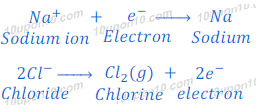
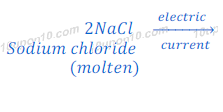
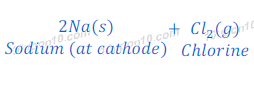
Molten sodium chloride is used only to obtain sodium metal and not the aqueous solution of sodium chloride. This is because when electric current is passed through the aqueous solution of sodium chloride, the sodium metal deposited at the cathode reacts with water present in the solution and forms sodium hydroxide.

Extraction of Aluminium metal
Aluminium metal is extracted through electrolytic reduction similar to sodium metal.
When electric current is passed through the molten aluminium oxide, aluminium ion is attracted towards cathode because of positively charged. At cathode aluminium ion gets electrons from cathode and forms aluminium metal.
On the other hand, oxide ion attracted towards anode because of having negative charge over them. At anode oxide ions lose electrons and form oxygen gas.
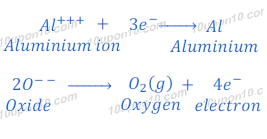

Refining of metals
Metals obtained by different processes of extraction contain many impurities, except those obtained from electrolytic reduction. Thus, impure metals obtained by different process are refined to obtain pure metals.
There are many processes by which impure metals are refined, but electrolytic refining is one of the most prevalent methods.
In the process of electrolytic refining a block of impure metal and a thin strip of pure metal is taken for electrolysis. A soluble salt of respective metal is used as electrolyte. Block of impure metal and thin strip of pure metal is dipped in the electrolyte. Block of impure metal is connected with positive pole and thin strip of pure metal is connected with the negative pole of electric source. This means impure metal is taken as anode while pure metal is taken as cathode.
After passing of electric current, impure metal dissolve from anode and deposited as pure metal at cathode. Water soluble impurities present in impure metal are got dissolved in solution and insoluble impurities are settled down at bottom of anode. Impurities settled at bottom near anode in the solution are known as anode mud.
Example:
Electrolytic Refining of copper
Impure Copper metal obtained after reduction of copper oxide is refined by the process of electrolytic refining.
A thick block of impure copper metal and a thin strip of pure copper metal are taken. These two blocks are dipped in the copper sulphate solution. Block if impure copper metal is connected with positive pole and strip of pure copper metal is connected with negative pole of electric source.
When electric current is passed through the electrodes, block of impure copper metal is dissolved and pure copper metal is deposited over cathode. Impurities from block of copper are settled down in the form of anode mud in the solution.
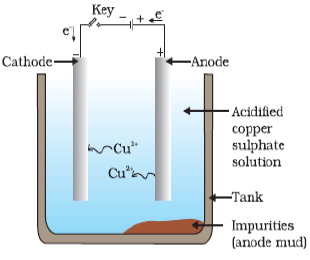
Ref: Image taken from NCERT Book
In this process copper metal from impure block of copper lose electrons and form copper ion in the solution. From solution positively charged copper ion attracted towards cathode, gets electron and converted into copper metal and deposited at cathode.
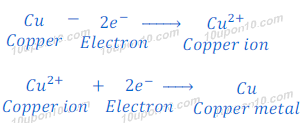
Metal obtained after electrolytic refinement is in pure form.